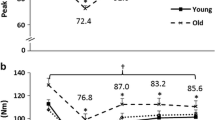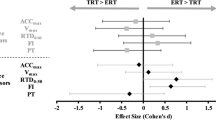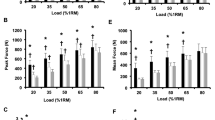Abstract
The underlying factors related to the divergent findings of age-related fatigue for dynamic tasks are not well understood. The purpose here was to investigate age-related fatigability and recovery between a repeated constrained (isokinetic) and an unconstrained velocity (isotonic) task, in which participants performed fatiguing contractions at the velocity (isokinetic) or resistance (isotonic) corresponding with maximal power. To compare between tasks, isotonic torque–power relationships were constructed prior to and following both fatiguing tasks and during short-term recovery. Contractile properties were recorded from 9 old (~75 years) and 11 young (~25 years) men during three testing sessions. In the first session, maximal power was assessed, and sessions 2 and 3 involved an isokinetic or an isotonic concentric fatigue task performed until maximal power was reduced by 40 %. Compared with young, the older men performed the same number of contractions to task failure for the isokinetic task (~45 contractions), but 20 % fewer for the isotonic task (p < 0.05). Regardless of age and task, maximal voluntary isometric contraction strength, angular velocity, and power were reduced by ~30, ~13, and ~25 %, respectively, immediately following task failure, and only isometric torque was not recovered fully by 10 min. In conclusion, older men are more fatigable than the young when performing a repetitive maximal dynamic task at a relative resistance (isotonic) but not an absolute velocity (isokinetic), corresponding to maximal power.





Similar content being viewed by others
References
Aagaard P, Suetta C, Caserotti P, Magnusson SP, Kjaer M (2010) Role of the nervous system in sarcopenia and muscle atrophy with aging: strength training as a countermeasure. Scand J Med Sci Sports 20:49–64. doi:10.1111/j.1600-0838.2009.01084.x
Allen DG, Lamb GD, Westerblad H (2008) Skeletal muscle fatigue: cellular mechanisms. Physiol Rev 88:287–332. doi:10.1152/physrev.00015.2007
Baudry S, Klass M, Pasquet B, Duchateau J (2007) Age-related fatigability of the ankle dorsiflexor muscles during concentric and eccentric contractions. Eur J Appl Physiol 100:515–525. doi:10.1007/s00421-006-0206-9
Bean JF, Latham NK, Holt N, Kurlinksi L, Ni P, Leveille S, Percac-Lima S, Jette A (2013) Which neuromuscular attributes are most associated with mobility among older primary care patients? Arch Phys Med Rehabil 94:2381–2388. doi:10.1016/j.apmr.2013.07.026
Callahan DM, Kent-Braun JA (2011) Effect of old age on human skeletal muscle force-velocity and fatigue properties. J Appl Physiol 111:1345–1352. doi:10.1152/japplphysiol.00367.2011
Callahan DM, Foulis SA, Kent-Braun JA (2009) Age-related fatigue resistance in the knee extensor muscles is specific to contraction mode. Muscle Nerve 39:692–702. doi:10.1002/mus.21278
Cheng AJ, Rice CL (2005) Fatigue and recovery of power and isometric torque following isotonic knee extensions. J Appl Physiol 99:1446–1452. doi:10.1152/japplphysiol.00452.2005
Christie AD, Snook EM, Kent-Braun JA (2011) Systematic review and meta-analysis of skeletal muscle fatigue and old age. Med Sci Sport Exerc 43:568–577. doi:10.1249/MSS.0b013e3181f9b1c4.Systematic
Christie AD, Tonson A, Larsen RG, DeBlois JP, Kent JA (2014) Human skeletal muscle metabolic economy in vivo: effects of contraction intensity, age, and mobility impairment. Am J Physiol Regul Integr Comp Physiol 307:R1124–R1135. doi:10.1152/ajpregu.00083.2014
Dalton BH, Harwood B, Davidson AW, Rice CL (2010a) Recovery of motoneuron output is delayed in old men following high-intensity fatigue. J Neurophysiol 103:977–985. doi:10.1152/jn.00908.2009
Dalton BH, Power GA, Vandervoort AA, Rice CL (2010b) Power loss is greater in old men than young men during fast plantar flexion contractions. J Appl Physiol 109:1441–1447. doi:10.1152/japplphysiol.00335.2010
Dalton BH, Power GA, Vandervoort AA, Rice CL (2012) The age-related slowing of voluntary shortening velocity exacerbates power loss during repeated fast knee extensions. Exp Gerontol 47:85–92. doi:10.1016/j.exger.2011.10.010
Dalton BH, Allen MD, Power GA, Vandervoort AA, Rice CL (2014) The effect of knee joint angle on plantar flexor power in young and old men. Exp Gerontol 52:70–76
Deschenes MR, Holdren AN, McCoy RW (2008) Adaptations to short-term muscle unloading in young and aged men. Med Sci Sports Exerc 40:856–863. doi:10.1249/MSS.0b013e318164f4b6
Jones DA, de Ruiter CJ, de Haan A (2006) Change in contractile properties of human muscle in relationship to the loss of power and slowing of relaxation seen with fatigue. J Physiol 576:913–922. doi:10.1113/jphysiol.2006.116343
Justice JN, Mani D, Pierpoint LA, Enoka RM (2014) Fatigability of the dorsiflexors and associations among multiple domains of motor function in young and old adults. Exp Gerontol 55:92–101. doi:10.1016/j.exger.2014.03.018
Kent-Braun JA (2009) Skeletal muscle fatigue in old age: whose advantage? Exerc Sport Sci Rev 37:3–9. doi:10.1097/JES.0b013e318190ea2e
Laforest S, St-Pierre DMM, Cyr J, Gayton D (1990) Effects of age and regular exercise on muscle strength and endurance. Eur J Appl Physiol Occup Physiol 60:104–111. doi:10.1007/BF00846029
Lanza IR, Towse TF, Caldwell GE, Wigmore DM, Kent-Braun JA (2003) Effects of age on human muscle torque, velocity, and power in two muscle groups. J Appl Physiol 95:2361–2369. doi:10.1152/japplphysiol.00724.2002
Lanza IR, Russ DW, Kent-Braun JA (2004) Age-related enhancement of fatigue resistance is evident in men during both isometric and dynamic tasks. J Appl Physiol 97:967–975. doi:10.1152/japplphysiol.01351.2003
Lanza IR, Befroy DE, Kent-Braun JA (2005) Age-related changes in ATP-producing pathways in human skeletal muscle in vivo. J Appl Physiol 99:1736–1744. doi:10.1152/japplphysiol.00566.2005
Lanza IR, Larsen RG, Kent-Braun JA (2007) Effects of old age on human skeletal muscle energetics during fatiguing contractions with and without blood flow. J Physiol 583:1093–1105. doi:10.1113/jphysiol.2007.138362
Layec G, Trinity JD, Hart CR, Kim S-E, Groot HJ, Le Fur Y, Sorensen JR, Jeong E-K, Richardson RS (2014) In vivo evidence of an age-related increase in ATP cost of contraction in the plantar flexor muscles. Clin Sci (Lond) 126:581–592. doi:10.1042/CS20130442
Layec G, Hart CR, Trinity JD, Le Fur Y, Jeong E-K, Richardson RS (2015) Skeletal muscle work effigiency with age: the role of non-contractile processes. Clin Sci 128:213–223
Lindstrom B, Lexell J, Gerdle B, Downham D (1997) Skeletal muscle fatigue and endurance in young and old men and women. J Gerontol Biol Sci 52:59–66
McNeil CJ, Rice CL (2007) Fatigability is increased with age during velocity-dependent contractions of the dorsiflexors. J Gerontol Ser A Biol Sci Med Sci 62:624–629. doi:10.1093/gerona/62.6.624
Mcphee JS, Maden-Wilkinson TM, Narici MV, Jones DA, Degens H (2014) Knee extensor fatigue resistance of young and older men and women performing sustained and brief intermittent isometric contractions. Muscle Nerve 50:393–400. doi:10.1002/mus.24174
Newham DJ, Jones DA, Turner DL, McIntyre D (1995) The metabolic costs of different types of contractile activity of the human adductor pollicis muscle. J Physiol 488:815–819. doi:10.1113/jphysiol.1995.sp021013
Petrella JK, Kim J, Tuggle SC, Hall SR, Bamman MM (2005) Age differences in knee extension power, contractile velocity, and fatigability. J Appl Physiol 98:211–220. doi:10.1152/japplphysiol.00294.2004
Pojednic RM, Clark DJ, Patten C, Reid K, Phillips EM, Fielding RA (2012) The specific contributions of force and velocity to muscle power in older adults. Exp Gerontol 47:608–613. doi:10.1016/j.exger.2012.05.010
Power GA, Dalton BH, Rice CL, Vandervoort AA (2011) Reproducibility of velocity-dependent power: before and after lengthening contractions. Appl Physiol Nutr Metab 36:626–633. doi:10.1139/h11-068
Power GA, Dalton BH, Rice CL (2013) Human neuromuscular structure and function in old age: a brief review. J Sport Heal Sci 2:215–226. doi:10.1016/j.jshs.2013.07.001
Power GA, Allen MD, Booth WJ, Thompson RT, Marsh GD, Rice CL (2014) The influence on sarcopenia of muscle quality and quantity derived from magnetic resonance imaging and neuromuscular properties. Age (Dordr) 36:9642. doi:10.1007/s11357-014-9642-3
Raj IS, Bird SR, Shield AJ (2010) Aging and the force-velocity relationship of muscles. Exp Gerontol 45:81–90. doi:10.1016/j.exger.2009.10.013
Rawson ES (2010) Enhanced fatigue resistance in older adults during repeated sets of intermittent contractions. J Strength Cond Res 24:251–256
Roos MR, Rice CL, Connelly DM, Vandervoort AA (1999) Quadriceps Muscle strength, contractile properties, and motor unit firing rates in young and old men. Muscle Nerve 22:1094–1103
Tevald MA, Foulis SA, Lanza IR, Kent-Braun JA (2010) Lower energy cost of skeletal muscle contractions in older humans. Am J Physiol Regul Integr Comp Physiol 298:R729–R739. doi:10.1152/ajpregu.00713.2009
Thompson BJ, Conchola EC, Palmer TB, Stock MS (2014) Effects of aging on maximal and rapid velocity capacities of leg extensors. Exp Gerontol 58:128–131
Valour D, Ochala J, Ballay Y, Pousson M (2003) The influence of ageing on the force—velocity—power characteristics of human elbow flexor muscles. Exp Gerontol 38:387–395
Yoon T, Schlinder-Delap B, Hunter SK (2013) Fatigability and recovery of arm muscles with advanced age for dynamic and isometric contractions. Exp Gerontol 48:259–268
Acknowledgments
The authors would like to thank all participants of the study, and to acknowledge Demetri Makrakos and Amelia Lanning for their help with data collection and analysis. The authors are grateful to Dr. Anita Christie for comments on a previous version of this manuscript. This work was supported by the Natural Sciences and Engineering Research Council (NSERC) of Canada. G.A. Power was supported by a Banting postdoctoral fellowship (Canadian Institutes for Health Research; CIHR) and Alberta Innovates Health Solutions (AIHS).
Author information
Authors and Affiliations
Corresponding author
About this article
Cite this article
Dalton, B.H., Power, G.A., Paturel, J.R. et al. Older men are more fatigable than young when matched for maximal power and knee extension angular velocity is unconstrained. AGE 37, 49 (2015). https://doi.org/10.1007/s11357-015-9790-0
Received:
Accepted:
Published:
DOI: https://doi.org/10.1007/s11357-015-9790-0




